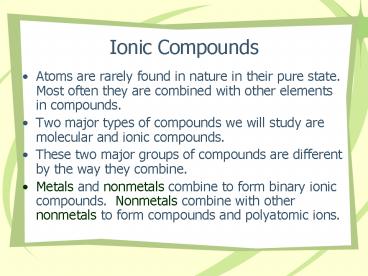Ionic Compounds PowerPoint PPT Presentation
1 / 7
Title: Ionic Compounds
1
Ionic Compounds
- Atoms are rarely found in nature in their pure
state. Most often they are combined with other
elements in compounds. - Two major types of compounds we will study are
molecular and ionic compounds. - These two major groups of compounds are different
by the way they combine. - Metals and nonmetals combine to form binary ionic
compounds. Nonmetals combine with other
nonmetals to form compounds and polyatomic ions.
2
Forming Ions
- Ions are elements which have gained or lost one
or more electrons. - Elements gain or lose electrons to achieve
greater stability. - Many atoms gain or lose electrons to become
isoelectronic with the noble gases. - Electrons are gained or lost from the outermost
electron shell. - A general rule is Last one in is the first one
out.
3
Forming Ions
- If atoms lose electrons they become positively
charged because they have more protons than
electrons. - These ions are called Cations.
- The metals of the periodic table form cations.
- Lithium loses its outer electron and becomes
isoelectronic with the noble gas helium. - The lithium ion is then written as Li
- An ion and its element have different physical
and chemical properties.
4
Forming Ions
- If atoms gains electrons they become negatively
charged because they have more electrons than
protons. - These ions are called Anions.
- The nonmetals of the periodic table form anions.
- Fluorine gains an outer electron and becomes
isoelectronic with the noble gas Neon. - The fluorine ion is then written as F-
- An ion and its element have different physical
and chemical properties.
5
Forming Ions
- Many metals and nonmetals form predictable ions.
- All alkali metals, with hydrogen, form 1
cations. - All alkaline earth metals form 2 cations.
- Aluminum forms a 3 cation, Al3.
- All halogens for -1 anions.
- Column 16 nonmetals form -2 anions.
- Column 15 nonmetals form -3 anions.
- Carbon does not form an ion, nor do the
metalloids with the exception of arsenic, As3-.
6
5.1 Ions
- Transition and post transition metals form
cations that are not as predictable as column I
II elements. - Transition metals may form more than one type of
cation. - Most transition metals form ions to achieve
stability in some other way than being
isoelectronic with the noble gases.
7
- Losing electrons is also called oxidation.
- The chart below shows the possible oxidation
states of the transition metals. - Notice that most of them form multiple ions.

